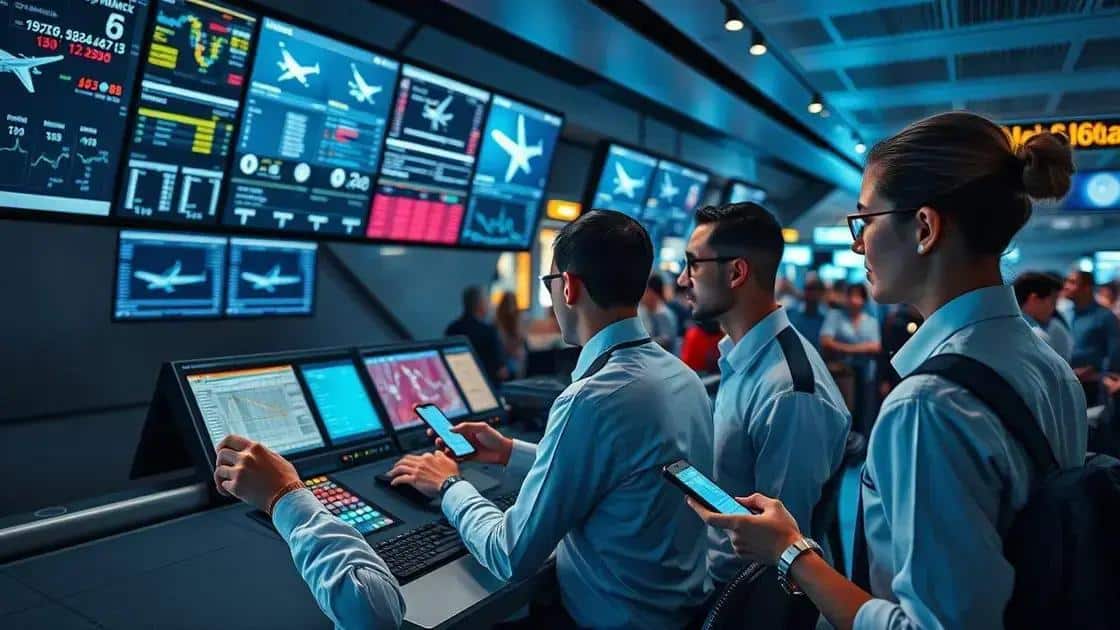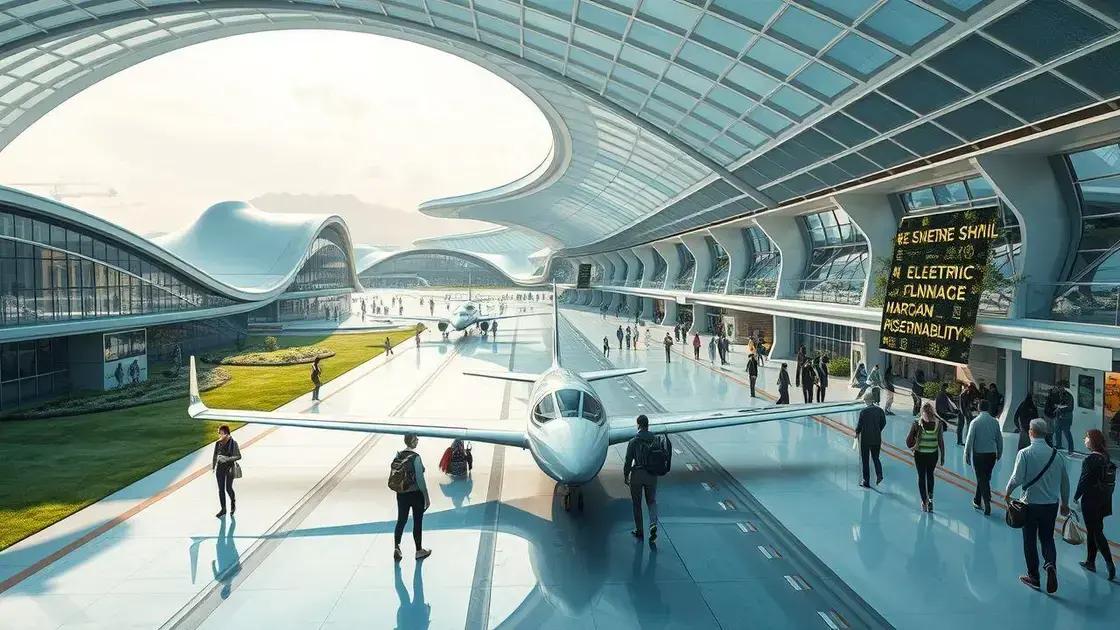Airline earnings recession 2025: what you need to know
Anúncios
The airline earnings recession in 2025 is driven by rising operational costs, changes in consumer behavior, and economic instability, prompting airlines to focus on sustainability, technology, and customer flexibility to navigate these challenges.
Airline earnings recession 2025 is a term that’s starting to pop up in conversations among travelers and industry experts. What’s fueling this trend, and how might it affect your next trip? Let’s take a closer look.
Understanding the airline earnings recession
Understanding the airline earnings recession is crucial for anyone interested in the travel industry. The fluctuations in airline revenues affect not just the companies, but travelers and the economy as a whole. This recession can bring about significant changes in services, pricing, and operational strategies.
What Does the Recession Mean?
When we talk about a recession in airline earnings, it indicates a decline in profits across the industry. Various factors contribute to this downturn, such as increased fuel prices, decreased consumer demand, and economic instability. Such factors create challenges for airlines, forcing them to adapt their strategies to maintain profitability.
Key Factors Influencing the Recession
The following factors play a major role in shaping the current airline earnings landscape:
- ⛽ Fuel prices: Rising costs can eat into profits
- ✈️ Consumer demand: Fluctuations in travel habits impact revenues
- 🌍 Economic conditions: Global economic trends heavily influence the sector
- 🏷️ Competition: Price wars among airlines can lead to lower earnings
Each of these components builds a complex web of influence on airlines. For example, as fuel prices rise, airlines may need to pass these costs onto travelers through higher ticket prices. Consequently, that can reduce consumer demand, leading to a vicious cycle.
Furthermore, economic conditions play a pivotal role. For instance, during times of uncertainty, people are less likely to travel, affecting airline bookings. This decline can lead to a reduction in flight frequencies and, ultimately, job cuts in the industry.
As we analyze the airline earnings recession, it becomes clear that understanding these core elements is vital. The decisions made today by airline executives will have lasting impacts, potentially changing the travel landscape entirely. Ongoing monitoring and adaptation are essential to stay afloat during these tumultuous times.
Causes of the 2025 downturn

The causes of the 2025 downturn in the airline industry are complex and multi-faceted. Understanding these factors is essential for anyone involved in travel or airline operations. Several pressing issues have emerged that directly impact airline earnings and operations.
Economic Factors
One of the main contributors to the downturn is economic instability. As global markets fluctuate, consumer confidence tends to wane. This can lead to decreased travel spending, which is critical for airlines.
Increased Operational Costs
Another factor to consider is rising operational costs. Airlines are facing higher expenses related to fuel, maintenance, and labor. Increased fuel prices, in particular, put pressure on profit margins.
- Fuel prices: Volatile oil markets can dramatically affect costs.
- Labor costs: Wages and benefits are continually rising.
- Maintenance costs: Aging fleets require more investment.
These increased costs can persuade airlines to up their ticket prices, which often leads to fewer passengers. This cycle of cost increases and declining demand can further exacerbate the earnings recession.
Consumer Behavior Changes
Shifts in consumer behavior also play a significant role. After the pandemic, many travelers remain cautious. A rise in remote work has reduced the demand for business travel, a major profit generator for airlines. Leisure travel patterns have also shifted, as more people are looking for lower-cost options or opting for road trips instead.
Environmental concerns are another trend influencing consumer choices. Travelers are more mindful of their carbon footprints and may choose airlines that prioritize sustainability. This shift can alter market dynamics, influencing which airlines thrive and which struggle.
The upcoming downturn in 2025 reflects not just one issue but a combination of pressures. As airlines navigate these challenges, understanding the root causes is essential for stakeholders looking to adapt to a rapidly changing landscape.
Impact on travel costs for consumers
The impact on travel costs for consumers during the airline earnings recession is significant and multifaceted. As airlines face decreased revenues, it’s often the travelers who bear the brunt of rising costs. Understanding these changes can help consumers navigate the new travel landscape.
Rising Ticket Prices
One of the most immediate effects of the downturn is an increase in ticket prices. Airlines, needing to maintain profitability, may raise fares to cover lost revenue. This price hike can be seen across various flight routes, impacting both leisure and business travelers.
Additional Fees
Along with rising ticket prices, consumers may also encounter added fees. Airlines often introduce or increase charges for things like:
- Baggage fees: Expect higher costs for checked and carry-on luggage.
- Seat selection: Choosing a specific seat may come with extra charges.
- Flight changes: Altering a booking can result in increased fees.
These fees add up quickly, leading to a larger overall expense for travelers. Many consumers may find themselves spending significantly more than they initially budgeted for their trips.
Moreover, the impact on travel costs isn’t just about airlines. Associated travel expenses, like accommodation and meals, may also rise as the demand for services fluctuates with airline pricing strategies. For instance, when flights become more expensive, hotels in popular destinations may follow suit to capitalize on the reduced competition.
Travelers should also consider the benefits of being flexible. Off-peak traveling, exploring alternate airports, or booking in advance are strategies that can mitigate some of the rising costs. Staying informed about airline policies and adapting plans accordingly will be essential for consumers aiming to manage their travel expenses during this challenging time.
Predicted changes in airline operations

The predicted changes in airline operations due to the 2025 earnings recession are important for both airlines and consumers. As airlines adapt to evolving market conditions, various operational adjustments will likely emerge. Understanding these shifts can help travelers prepare for future journeys.
Streamlined Operations
A key change predicted is the streamlining of operations. Airlines may focus on improving efficiency to reduce costs. This can include optimizing flight schedules, consolidating routes, or even downsizing fleets. By making these changes, airlines can maintain profitability during challenging times.
Investment in Technology
Another area of focus will be an increased investment in technology. Airlines are likely to adopt more advanced tools for managing resources and enhancing customer experiences. Some trends include:
- 🤖 Automation: Using automated systems for check-in and boarding will speed up processes and cut labor costs
- 📊 Data analytics: Utilizing data to predict demand and optimize pricing strategies
- 📱 Contactless technology: Increasing the use of mobile apps for ticketing and customer service
These technological innovations can not only improve operational efficiency but also enhance passenger experiences, making travel smoother and more enjoyable.
Furthermore, airlines may also be more flexible with their policies. Adjustments to cancellation and change policies will likely reflect the need to adapt to fluctuating demand. For instance, more lenient rules can encourage travelers to book flights with confidence, knowing they can modify plans if necessary.
As airlines navigate the choppy waters of the upcoming recession, the focus on improving operational efficiency and enhancing technology will be crucial. By doing so, airlines can not only survive but also position themselves for growth when market conditions improve.
Responses from major airlines
The responses from major airlines to the 2025 earnings recession are crucial in shaping the future of air travel. With changing economic conditions, airlines are adopting various strategies to adapt and survive. These responses reflect their attempts to navigate through economic challenges while keeping passengers satisfied.
Cost-Cutting Measures
Many airlines are implementing cost-cutting measures to maintain profitability. This can include reducing workforce size or changing staff scheduling to optimize labor costs. Furthermore, some airlines may consider retiring older aircraft to lower maintenance expenses and improve fuel efficiency.
Enhanced Customer Flexibility
Another key response is an increase in customer flexibility. Airlines are recognizing that uncertain travel conditions require more adaptable policies. This can manifest in:
- Flexible booking options: Allowing passengers to change dates or destinations without hefty fees.
- Longer cancellation windows: Providing travelers with more time to decide on their plans.
- Refund options: Facilitating easier refunds for canceled flights.
Such measures aim to build customer loyalty in a challenging environment. By making travel easier, airlines hope to encourage bookings despite economic uncertainties.
Improved safety protocols have also become a priority. As traveler confidence remains critical, airlines are enhancing cleanliness standards and health measures on flights. This includes using advanced filtration systems and regular disinfection of aircraft.
Furthermore, engagement with travelers through social media and direct communication has increased. Airlines are actively reaching out to customers to solicit feedback and provide updates. This proactive approach helps airlines understand traveler needs and preferences as conditions evolve.
In summary, the responses from major airlines include cost management strategies, enhancing customer flexibility, and improving health measures. Staying competitive in the face of economic downturns is a significant challenge, and these responses aim to safeguard both the airlines and their passengers during turbulent times.
Future outlook for the airline industry

The future outlook for the airline industry is a topic of significant interest, especially as the 2025 earnings recession unfolds. As airlines adapt to economic pressures, several trends are likely to shape the future of air travel.
Emphasis on Sustainability
One major trend is the increasing emphasis on sustainability. Airlines are under pressure to reduce their carbon footprints and implement greener practices. This can include using more fuel-efficient aircraft and investing in sustainable aviation fuels. Many companies recognize that environmentally friendly practices are becoming essential for attracting a growing number of eco-conscious travelers.
Technological Advancements
Technological advancements will continue to play a crucial role in the industry. Innovations such as:
- 🤖 Artificial Intelligence: AI will help airlines optimize routes and manage resources effectively
- 🧑💼 Biometric technology: Streamlining check-in and boarding processes for a smoother travel experience
- 📊 Data analytics: Understanding customer behaviors to tailor services more effectively
These technologies not only improve operational efficiency but also enhance passenger experiences. Travelers can expect quicker check-ins and personalized service as airlines leverage data and technology.
Moreover, increasing competition could lead to changes in pricing structures. Airlines may offer more competitive fares, especially for leisure travelers, as they attempt to attract customers in a crowded market. Special promotions and discounts could become common as airlines try to recover from the recent downturn.
Additionally, partnerships and alliances among airlines are likely to grow. Collaborations can help companies share resources, reduce costs, and expand their networks. Such strategies will enable airlines to remain resilient amid ongoing economic challenges.
Overall, the future outlook for the airline industry suggests a landscape marked by innovation, sustainability, and competitive pricing strategies. As airlines adapt to these changes, they will be better positioned to meet the evolving expectations of travelers.
FAQ – Frequently Asked Questions about the Airline Industry Outlook
What trends are shaping the future of the airline industry?
Key trends include a focus on sustainability, technological advancements, and increased customer flexibility.
How are airlines responding to the earnings recession?
Airlines are cutting costs, enhancing safety measures, and improving customer engagement to adapt to the economic challenges.
Will flight prices increase due to the recession?
Prices may rise due to higher operational costs, but competitive pricing strategies might also lead to occasional discounts.
What technologies are airlines investing in for the future?
Airlines are adopting AI, automation, and data analytics to improve operational efficiency and customer experiences.






